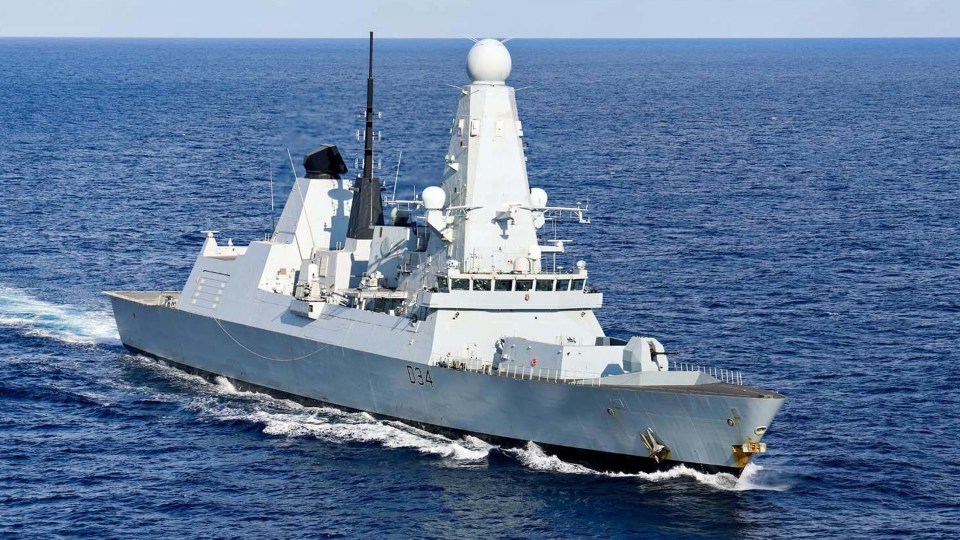A ROYAL Navy warship has shot down an attack drone launched by Iran-backed rebels in the Red Sea.
The HMS Diamond fired a Sea Viper missile to blast the kamikaze drone out of the sky.
The HMS Diamond, pictured, shot down an attack drone launched by Iran-backed rebels
Paul EdwardsThe Type 45 Destroyer is one of the Navy’s most powerful warships[/caption]
It was the first time the Royal Navy has fired air defence weapons in anger for more than 30 years.
The drone was attacking a merchant vessel in one of the world’s busiest shipping lanes.
Defence Secretary Grant Shapps confirmed the engagement on Twitter.
He said: “HMS Diamond has shot down a suspected attack drone targeting merchant shipping in the Red Sea – destroying the target with a Sea Viper missile.
“The recent spate of illegal attacks represent a direct threat to international commerce and maritime security in the Red Sea.
” The UK remains committed to repelling these attacks to protect the free flow of global trade.”
The Type 45 Destroyer was ordered to sail to the Gulf amid fears that the war in Israel could spiral into a regional conflict.
It comes days after a USS Carney, a US Navy guided missile destroyer, shot down multiple drones fired by suspected Houthi rebels in Yemen.
It was at least the third time US warships have fired on Houthi missiles and drones since Hamas launched their October 7 massacre.
HMS Diamond’s engagement was the first time a Royal Navy warship shot down an aerial target since HMS Gloucester used its Sea Viper missiles in the 1991 Gulf War to shoot down an Silkworm anti-ship missile.
Shapps added: “The ship recently arrived in the region to bolster international efforts to maintain maritime security.
“The recent spate of illegal attacks represent a direct threat to international commerce and maritime security in the Red Sea.
“The UK remains committed to repelling rhese attacks to protect the free flow of global trade.”
The ship’s captain Commander Peter Evans ordered the crew to fire a single Sea Viper missile which hit the target in seconds.
The 16ft long missiles launch vertically from the ship’s foredeck at four times the speed of sound and “manoeuvre for the kill at G-forces no human can withstand”.
Together with the warship’s distinctive Samson Radar – which towers 40 metres over the water – it can track up to 1000 objects the size of cricket balls travelling at three times the speed of sound up to 250 miles away.
A Navy source said it was “one shot one kill” in the overnight engagement.
The Royal Navy has six Type 45 destroyers and each can carry up to 48 Sea Viper missiles which can be launched “at the flick of a switch”.
Chief of Defence Staff Admiral Tony Radakin hinted more had been moved to the region to resupply the warship if necessary.
The same ship was used to defend London from attacks during King Charles’ coronation.
The vessel’s 200 crew will spend Christmas in the Gulf, alongside the frigate HMS Lancaster, three Royal Navy mine hunters and a Royal Fleet Auxiliary support ship already in the region.
It comes after Britain sent eight warships on missions – from the Baltic to the Gulf – amid fears that Russian meddling and war in Gaza could spiral into global conflict.
In November, HMS Diamond, a guided missile destroyer, was set to steam through the Suez Canal in a show of force to Hamas-backers Iran.
The type 45 destroyer is one of the Navy’s most powerful warships,armed with dozens of Sea Viper missiles that can intercept rockets, jets, drones and intercontinental ballistic missiles up to 75 miles away.
Combined with the vessel’s Samson radar the ship can track up to 1,000 objects the size of small as a tennis ball travelling three times the speed of sound.
Its mission follows a spate of attacks by Iran-backed Houthi rebels in Yemen.
They hijacked a cargo ship on Nov 19 and fired missiles and drones at Israel and a US warship the USS Mason.
Grant Shapps said HMS Diamond’s main mission was to act as a “deterrent” to Iran.
He said: “Iran, under the wrong circumstances, may try to stir this all up.”
He added: “It is critical that the UK bolsters our presence in the region, to keep Britain and our interests safe.”
HMS Defender will join the frigate HMS Lancaster, three Royal Navy mine hunters and a Royal Fleet Auxiliary support ship already in the region.
Separately, a fleet of frigates, gunboats and mine hunters, will set sail within in days to defend undersea cables in the Baltic and North Sea along with allies from UK-led Joint Expeditionary Force (JEF).
It is the first time the 10-alliance, which includes Denmark, Finland, Estonia, Iceland, Latvia, Lithuania, the Netherlands, Sweden and Norway, has activated a “response” protocol to counter Russian threats.
It follows repeated warnings Russian activity that could threaten undersea internet cables, powerlines from windfarms and oil and gas pipelines.
Shapps hailed the mission as an “historic and unprecedented”.
He said: “The UK and our JEF partners will do whatever it takes to defend our mutual areas of interest, and today’s display of unshakeable unity sends a powerful message of deterrence that we stand ready to meet any potential threat with force.
“Together, we stand firmly in support of peace, security, and a steadfast resolve to uphold the rules-based international order.”
The seven vessel task force includes a Royal Fleet Auxilliary landing ship, RFA Mounts Bay, designed to launch coastal assaults with commandos.
The other vessels are HMS Richmond, HMS Somerset, HMS Severn, HMS Tyne, HMS Cattistock, HMS Penzance, RFA Mounts Bay and an RAF P-8 Poseidon sub-hunting patrol aircraft based at RAF Lossiemouth.

